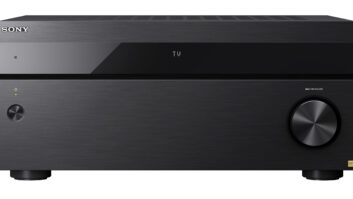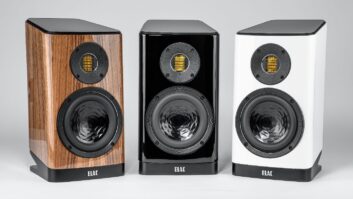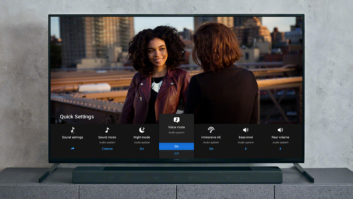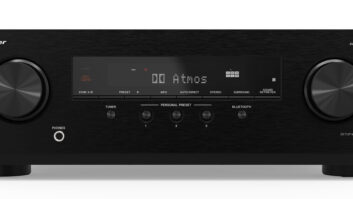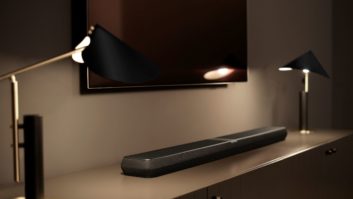When Sony launched its new ES receiver lineup at CEDIA 2014, the products were riding the cutting edge. Not only were these models designed specifically with custom integration in mind–including numerous features designed to speed up and simplify installations, and also providing deep support for multiple third-party controllers–these new AVRs were also among the very first products to market capable of supporting HDMI 2.0 with HDCP 2.2 for true 4K sources.
However, technology stands still for no one, and these initial ES receiver offerings were eclipsed pretty quickly by new advances. For one, Sony’s first ES models featured only one or two HDMI 2.0 inputs and used an early HDMI 2.0 chipset that was bandwidth-limited to 9Gbps instead of the full 18Gbps. Further, none of the models supported object-based audio decoding for Dolby Atmos or DTS:X. Whereas virtually every other manufacturer revamped their lineups to take advantage of these advances, Sony left the lineup as is. Additionally, the ES lineup was missing a true flagship product.

Fortunately for Sony dealers, the company rectified all of these shortcomings with the launch of the new STR-ZA5000ES receiver. Not only does this model feature a suite of full-bandwidth HDMI 2.0 inputs along with dual outputs, it also supports processing for an 11-channel (7.1.4) Atmos or DTS:X audio system. Sony also seriously upped the performance chops, borrowing some cues from the previous STR-DA5800ES flagship along with some other upgrades and redesigns to the audio portion, to produce a model worthy of sitting atop its lineup.
Pulling the 5000ES from the box, it’s clear this is a beast with serious build quality under the hood. And while it’s true you can’t totally judge an amp/receiver merely by its poundage, with this clocking in just under 38 pounds it’s apparent Sony didn’t skimp on the goods. Part of the added weight comes from the fact that this model is capable of driving the nine onboard 130-watt power amplifiers. To drive this, Sony endowed the 5000 with a significantly larger power transformer than the model used in the 3000ES and the transformer is held in place with a 2-millimeter-thick steel plate, producing more chassis rigidity.

To further improve audio quality, Sony outfitted the 5000 with a new high-resolution preamp circuit delivering significantly faster response, higher signal-to-noise ratio, and producing a much lower noise floor. This also gives the 5000 finer, 0.5dB volume adjustment steps, delivering more precise volume control. To support Dolby Atmos and DTS:X, the 5000 also has new, more powerful 32-bit DSPs.
Sony did everything possible to make installing the ZA5000 a treat rather than a chore, with a well-designed back panel that’s packed with connections, yet is kept from feeling overly crowded by stripping out many unnecessary or no longer needed connectors. There are just two composite and two component video inputs, no component output, only four analog audio inputs (no phono), and three digital audio inputs (two optical, one coax).
The 5000 is long on what every modern system needs, including six HDMI (five rear/one front) inputs and two outs, along with zone 2 and 3 analog audio. Awesomely, Sony put a DAC ahead of the zone 2 output, so any digital inputs are available for listening. Control wise, the 5000ES supports AMX, Crestron, Control4, Elan, RTI, Savant, URC, and Vantage integration via IP. There are also three separate 12-volt triggers, IR control in/out, and RS-232. Also incredibly handy is the eight-port gigabit switch including two PoE ports. Call this a $100-plus add-on feature that is welcome in nearly every modern system.
The nine-channel speaker binding posts are smartly arrayed along the bottom of the receiver, featuring five-way binding posts. If the 130-watt amplification isn’t enough for you–hard to imagine unless you have some incredibly difficult-to-drive speakers–pre-out connections are available for all channels, including two subwoofers.
While the 5000ES doesn’t have any streaming features, it does support Sony’s unique and impressive Music Connect. With this, the Sony can “scan” your network and find certain network players like Sony’s own HAP-Z1ES or a Sonos player. Once configured, whenever that player begins playing–say from the Sonos app–the receiver automatically turns on, switches to the correct input and volume level. This takes about 30 seconds to set up and is really an awesome feature.
Two other unique features demand mention. First is the receiver’s ability to produce video test patterns in 4K/60Hz/4:4:4, 4K/24Hz/4:4:4, 1080p, and 480 at 60Hz resolutions. This is incredibly beneficial to test that your display and signal chain are capable of handling these high bandwidth signals. Second is support of Ihiji monitoring. With this, Ihiji dealers can log in and check on a variety of conditions, as well as reboot and update.
Configuring the 5000 is lightning fast and primarily performed using the incredibly well designed Web GUI, which provides near-instant access to every configurable feature on the receiver.
I spent a lot of time listening to the 5000ES, watching scenes or entire films from numerous Dolby Atmos and DTS:X movies released to date, as well as UHD content from the new Kaleidescape Strato, and I can confidently say this receiver sounds terrific. The 5000 delivered all the dynamics, detail, impact, and sonics I’ve come to expect from object-based audio, producing a terrific hemispheric bubble of sound.
From the break of waves and wind crackling overhead and around the room as they hunt whales in In the Heart of the Sea, to the tight, confined spaces and mechanical buzzes and hums of District 13 in The Hunger Games: Mockingjay Part 1, the Sony never skipped a beat or sounded strained or fatigued. The amplifier also has gobs of power with tons in reserve. I like to watch movies at near cinematic levels, but never felt the need to push it beyond -10dB.
While primarily a “home theater” product, music listeners will be pleased with how the 5000 handles audio. From delicate, simple vocal and piano tracks like Ruth B’s “Lost Boy” to heavily processed fare like Beyonce’s tour-de-force “Lemonade,” the Sony delivered a wide presentation with plenty of depth and detail and a terrific phantom center image.
Sony wanted a flagship, statement product to stand atop its ES lineup and the STR-ZA5000ES delivers in spades. For integrators looking to take installs to the next level, this product delivers on all fronts.
877.865.7669
sony.com
Kudos
Terrific build and sound quality; wonderfully easy to configure and integrate; amazingly CI and consumer friendly
Concerns
Premium price; no 2-channel Sony amplifier; no app control
Product Specs
► 130-watts x 9 (8 Ohms, 1 kHz, 0.09% THD)
► Supports Dolby Atmos and DTS:X decoding up to 11.1 channel (using external 2-channel amplifier)
► 6×2 HDMI switching, with full 18Gbps bandwidth and support HDMI 2.0a/HDCP 2.2 4K/60p 4:4:4 with HDR and 4K upscaling (Input 6 supports bandwidth up to 9 Gbps)
► Analog audio Zone 2 and Zone 3 outputs
► 8-port gigabit ethernet switch with 2 PoE outputs
► Web browser configurable setup
► IP integration and support with AMX, Crestron, Control4, Elan, RTI, Savant, URC, and Vantage
► Ihiji remote monitoring
► Terrific five-year warranty
► Dimensions: 16.9 x 6.9 x 16.1-inches (WxHxD); 37.7 pounds
